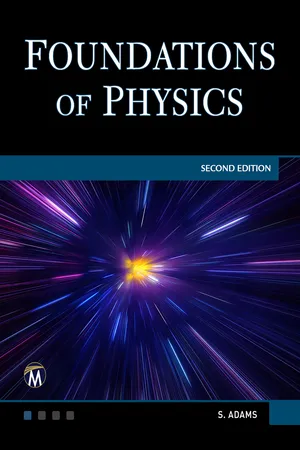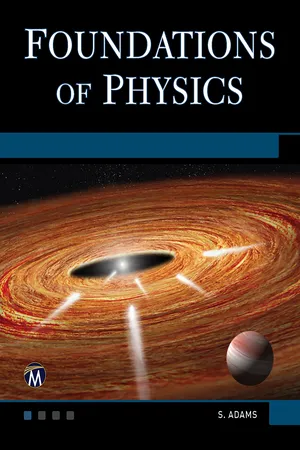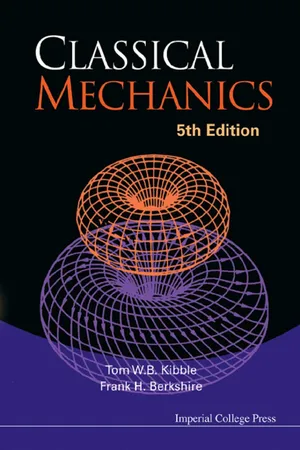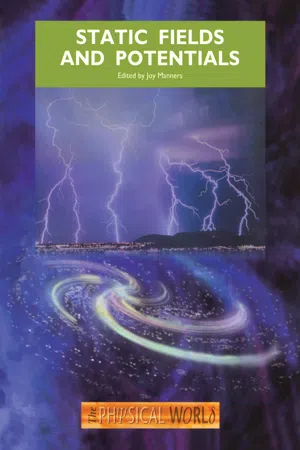Physics
Gravitational Potential
Gravitational potential is a measure of the potential energy per unit mass at a given point in a gravitational field. It represents the work that would be done in moving a unit mass from a reference point to the point in question. The gravitational potential is a scalar quantity and is used to calculate the gravitational potential energy of an object in a gravitational field.
Written by Perlego with AI-assistance
Related key terms
7 Key excerpts on "Gravitational Potential"
- eBook - ePub
- Steve Adams(Author)
- 2023(Publication Date)
- Mercury Learning and Information(Publisher)
x , that is, the sum of the component of the gravitational force in the direction of motion along each line element. The gravitational forces do work on the particle so its Gravitational Potential energy falls:The differential form of this equation is: The rate of change of Gravitational Potential energy with distance is equal in magnitude but opposite in direction to the gravitational force. Uniform Gravitational FieldChanges of Gravitational Potential energy in a uniform field of strength g provide a simple (and familiar) formula.While this is only exact when g is constant it is a good approximation for vertical displacements close to the surface of the Earth that are small compared to the radius of the Earth.23.2.2 Gravitational PotentialThe Gravitational Potential V G at a point in the field is equal to the Gravitational Potential energy per unit mass at that point.The SI unit for Gravitational Potential is the joule per kilogram (Jkg− 1 ).The zero of Gravitational Potential is taken to be at infinity.This is the same convention used to define the zero of electrical potential and it makes sense because when particles are separated by very large distances their interactions, under an inverse-square law, become negligible. Once we have defined the zero of potential, we can determine the absolute potential (and potential energy) at any point. This is equal to the work that must be done per unit mass to move a small mass from infinity and to place it at point P.Gravitational Potential at P a Distance r from a Point or Uniform Spherical Mass MA small mass m is moved from infinity and placed a distance r from a mass M .The change in Gravitational Potential energy of the small mass is: where All Gravitational Potential energies are negative because work would have to be done to move any mass to infinity. This is a consequence of the attractive nature of gravitational forces. - eBook - ePub
- Steve Adams(Author)
- 2019(Publication Date)
- Mercury Learning and Information(Publisher)
g being zero—it isn’t. They are in free fall with the same acceleration as their spacecraft, so they do not experience a reaction force to their own weight. The very fact that they are orbiting is because of their weight!23.2 Gravitational Potential Energy and Gravitational PotentialGravitational Potential energy is the energy a body has because of its position in the gravitational field. When it is moved from one position to another, energy is either transferred to or from Gravitational Potential energy. For example, lifting a case from the floor and placing it on a table requires an external agent to apply an upward force and to move this force; so work is done on the case and its Gravitational Potential energy increases.If an apple falls from a tree to the ground, a gravitational force (its weight) acts on the apple and does work on it, so its Gravitational Potential energy decreases.23.2.1 Change in Gravitational Potential EnergyConsider a particle of mass m moving from point A to B in a gravitational field as shown below.The work done by the gravitational field to move it a short distance δ x along the line AB is:So the total work done is:where mg. dxis the scalar product of the two vectors [[476-02]] mg and δ x, i.e., the sum of the component of the gravitational force in the direction of motion along each line element. The gravitational forces do work on the particle, so its Gravitational Potential energy falls:The differential form of this equation is: The rate of change of Gravitational Potential energy with distance is equal in magnitude but opposite in direction to the gravitational forceUniform gravitational fieldChanges of Gravitational Potential energy in a uniform field of strength gprovide a simple (and familiar) formula.While this is only exact when g is constant, it is a good approximation for vertical displacements close to the surface of the Earth that are small compared to the radius of the Earth.23.2.2 Gravitational PotentialThe Gravitational Potential VG at a point in the field is equal to the Gravitational Potential energy per unit mass at that point.The S.I. unit of Gravitational Potential is Jkg−1 - eBook - ePub
- Michael M. Mansfield, Colm O'Sullivan(Authors)
- 2020(Publication Date)
- Wiley(Publisher)
The Gravitational Potential energy of a mass m near the Earth is given by Equation (5.15), namely where M E is the mass of the Earth. Differentiating this equation we obtain If two points are at distances r and (r + Δr) respectively from the centre of the Earth we can write the potential energy difference between these points In the case of a mass which is moved to a height y above the Earth's surface Δr = y and r = R E, the radius of the Earth, so that ΔU can be written Recalling, from Equation (5.4), that, we can write the potential energy difference between the two points as The expression for the potential energy of a mass m in the uniform gravitational field near the Earth's surface given in Equation (5.14) is, therefore, a special case of the general equation for potential energy in the Earth's gravitational field; it is valid if y << R E. Case 2: A repulsive inverse square law force Although the gravitational inverse square law force can only be attractive, other inverse square law forces, such as the electrostatic force (Chapter 16), can be either repulsive or attractive. In the case of a repulsive inverse square law force, the potential energy varies with r according to the equation where C is a constant. Such a function is plotted in Figure 5.30. Note that in this case the restriction E ≥ U means that a particle which is subject to this force field is free to move anywhere between r = r 1 and r = ∞. As can be seen from Figure 5.30 the kinetic energy, and thus the velocity, of the particle increases as r increases. The gradient of the potential energy plot is always negative and decreases with r, thus confirming that the force is in the positive r direction (repulsion) and that it decreases with r. It should be clear from the foregoing that potential energy plots can be very useful tools for representing the main features of force fields - eBook - ePub
Newtonian Dynamics
An Introduction
- Richard Fitzpatrick(Author)
- 2021(Publication Date)
- CRC Press(Publisher)
CHAPTER 15 Gravitational Potential Theory DOI: 10.1201/9781003198642-15 15.1 Introduction The aim of this chapter is to employ Gravitational Potential theory to investigate the rotational flattening and tidal elongation of celestial bodies, as well as the precession of the equinoxes. 15.2 Gravitational Potential Consider two point masses, m and m ′, located at position vectors r and r ′, respectively. The vector gravitational force, f, that mass m ′ exerts on mass m is written f = G m m ′ r ′ − r | r ′ − r | 3. (15.1) Hence, the acceleration, g, of mass m as a result of the gravitational force exerted on it by mass m ′ takes the form g = G m ′ r ′ − r | r ′ − r | 3. (15.2) Now, the x -component of this acceleration is. written g x = G m ′ x ′ − x [ (x ′ − x) 2 + (y ′ − y) 2 + (z ′ − z) 2 ] 3 / 2, (15.3) where r = (x, y, z) and r ′ = (x ′, y ′, z ′). However, as is easily. demonstrated, x ′ − x [ (x ′ − x) 2 + (y ′ − y) 2 + (z ′ − z) 2 ] 3 / 2 ≡ ∂ ∂ x 1 [ (x ′ − x) 2 + (y ′ − y) 2 + (z ′ − z) 2 ] 1 / 2. Hence, g x = G m ′ ∂ ∂ x 1 | r[--=PLGO-SEPARATOR=. --]′ − r |, (15.5) with analogous expressions for g y and g z. It follows that g = − ∇ Φ ≡ − ∂ Φ ∂ x, ∂ Φ ∂ y, ∂ Φ ∂ z, (15.6) where Φ (r) = − G m ′ | r ′ − r | (15.7) is termed the Gravitational Potential. Incidentally, a comparison between Equation (5.44) and Equation (15.6) reveals that the Gravitational Potential energy of a mass m located at position vector r in a gravitational field whose Gravitational Potential is Φ (r) is simply U = m Φ (r). It is a well known experimental fact that gravity is a superposable force. In other words, the gravitational force exerted on some point mass by a collection of other point masses is simply the vector sum of the forces exerted on the former mass by each of the latter masses taken in isolation - eBook - ePub
- Tom W B Kibble, Frank H Berkshire(Authors)
- 2004(Publication Date)
- ICP(Publisher)
Chapter 6
Potential Theory
This chapter is complementary to the preceding ones. In it we shall discuss not the problem of determining the motion of a particle under known forces, but the problem of finding the forces from a knowledge of the positions of other bodies. We deal specifically with gravitational and electrostatic forces obeying the inverse square law, which are determined by the positions of other masses and charges.We return here to the convention whereby = dr/dt. We shall not use rotating frames again until Chapter 9 .6.1Gravitational and Electrostatic Potentials
The Gravitational Potential energy of a particle of mass m moving in the field of a fixed mass m′ at r′ is −Gmm′/|r − r′|. If we have several masses mj , located at the points r(The fact that the potential energies add follows from the additive property of forces.)j, then the potential energy is the sumSince the mass m appears only as an overall factor, we may define the Gravitational Potential Φ(r) to be the potential energy per unit massso thatNote that Φ is always negative. (The potential has sometimes been defined to be minus the potential energy per unit mass, and therefore positive. We prefer, however, to retain the direct correspondence between potential and potential energy, so that particles tend to move towards regions of lower potential.)The acceleration of a particle moving under gravitational forces is given bySince this acceleration is independent of the mass m, we may define the gravitational acceleration or gravitational field g(r) byThus (6.2) and (6.3) are all that is needed to calculate the acceleration induced in a particle by a given distribution of masses.The electrostatic case is very similar. We define the electrostatic potential ϕ(r - No longer available |Learn more
- Robert A. Pelcovits, Joshua Farkas(Authors)
- 2023(Publication Date)
- Barrons Educational Services(Publisher)
U to determine the change in the potential energy. Because the net force is constant, the following equation applies:Unless stated otherwise, the +y-direction is generally taken to point up when dealing with Gravitational Potential energy. Therefore, the work done by gravity as the object moves from y1 to y2 isComparing this equation with the definition of potential energy, W = −ΔU, reveals thatNote that our definition of potential energy involves only the difference in height between the two points. As we will continue to observe, it is only differences in potential energy (and, in this case, differences in height) that are significant. Therefore, we are free to choose any reference point where we define U = 0. For the case of gravity, we choose our reference point to be y = 0, such thatWhat happens if we set y = 0 at a different location? This changes the value of U at a particular point, but recall that it is the difference in potential energy that yields the work and ultimately the change in speed.Only differences in potential energy are significant. The actual magnitude of potential energy at any particular point is arbitrary and depends on the choice of coordinate systems.Potential energy, like work and kinetic energy, is a scalar with units of joules (J = Nm = kg·m2 /s2 ).To review various sign conventions, consider an object falling toward Earth under the influence of gravity. The gravitational force is parallel to the velocity, so gravity performs positive work on the object, increasing its speed (and thus its kinetic energy). The y-coordinate decreases so that U = mgy decreases and thus the potential energy decreases. You can verify that these signs are consistent with the equation Wgravity = −ΔUgravitational = −Δ(mgy) = ΔKE.Example 4.3You lift an object at constant velocity. What are the signs - eBook - ePub
- Joy Manners(Author)
- 2020(Publication Date)
- CRC Press(Publisher)
equipotential.Figure 2.12 (a) A contour map of a mountain, and (b) a cross-section along line XY of the same mountain. The slope is steepest where the contour lines are closest together.Equipotentials
These results are not restricted to the gravitational field. Imagine two point charges q1 and q2 separated by a distance R. Suppose q1 is held fixed at the origin, but q2 may be moved. We know from Section 3.2 that the potential due to q1 is:VEqn 2.11( r )=.q 14 πε 0rSince the electric field and potential due to a point charge are spherically symmetric, that is, the same in all directions, V depends only on the magnitude of r, not its direction, so we can write simplyV( r )=.q 14 πε 0rAt the location of q2 , where r = R, the potential due to q1 is V(R), so the potential energy of q2 is q2 V(R). Moreover, q2 may be moved from its initial position to any other point on the surface of an imaginary sphere of radius R, centred on q1 without any change in the energy of the system. All the points on this imaginary sphere are therefore at the same potential: the sphere describes an equipotential surface. Figure 2.13 shows spherical equipotential surfaces around a charge of 10−1 C at 1, 2, 3, 4 and 5 V (assuming V = 0 at infinity).Figure 2.13
Index pages curate the most relevant extracts from our library of academic textbooks. They’ve been created using an in-house natural language model (NLM), each adding context and meaning to key research topics.






